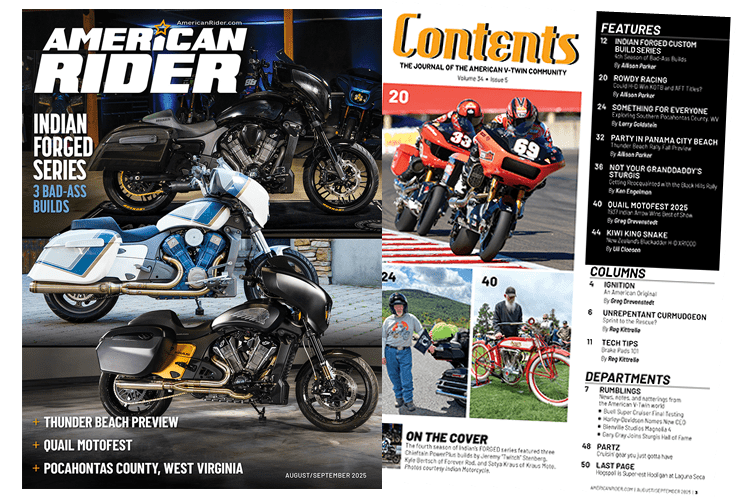
With the announcement on January 9 that Victory Motorcycles is being shuttered by parent corporation Polaris, the question that arises is not, “Why?” The question is, “Why did it take so long?” As a practical matter, the clock started running out on Victory with the purchase of the Indian motorcycle marque in 2011.
While the two brands would be “autonomous” businesses, according to the press release announcing the acquisition, it was no secret that the company was redirecting significant resources, including their premiere design and engineering talent, to their new enterprise.
From the outset, Victory Motorcycle was an enterprise of opportunism; the opportunity was Milwaukee’s exploding popularity and resulting struggles to meet demand in the early 90’s. That shortfall gave rise to scores of clone builders, and three OEMs: There was Wayne Baughman’s fraudulent Indian Motorcycle Manufacturing, and the Hanlon family’s equally suspect Excelsior-Henderson Motorcycle Company. And then there was Victory Motorcycles, which was backed by the deep pockets of Polaris Industries, and a totally legitimate effort. Only problem was, they were so slow out of the gate—taking five years to bring a bike to market—that by the time they had what they considered a saleable product, Milwaukee’s production had caught up. That left Victory in a pickle. A pickle they never quite extricated themselves from.
I’ve covered the company since its inception, and the thing that struck me most back then, and continued as an unresolved quandary, was the utter absence of a single unifying vision of what a Victory motorcycle was or should be. No Philip Vincent or Al Crocker here. No Oscar Hedstrom or William Harley. No Willie G.
They had Matt Parks. (I know. Who?) Lacking that aforementioned vision, the company essentially reverse-engineered a Harley and a Honda and birthed an unremarkable and visually clunky debut.
Lacking direction, and stymied by Harley’s prodigious production capacity growth, the company became even more of a study in imitative thinking. Scrutinize the market, see what’s selling, and make something like it. Always a day late, and always wide of the mark.
Aesthetically the company never quite rebounded entirely from their original ungainliness. An unprepossessing motor (to say the least), a troublesome tranny, fidgety handling, and an unfinished quality to many of its components, all gave rise to a palpable inferiority complex when going head-to-head against their presumed competition, Harley-Davidson. It was a mystifying strategy to begin with, and Victory never rose to the level of even a nuisance for Harley.
Frustrated in their inability to take a perceptible bite out of The Motor Company, Victory pivoted and set their sights on the then-burgeoning “production custom” market, represented most notably by Big Dog and American IronHorse, somehow thinking that a fat rear tire and loud paint jobs were the secrets to success in that arena. Predictably that campaign went nowhere—as ultimately did the entire production custom industry.
They thus changed course yet again, targeting the well-established luxo-tourer market with the creation of the 2008 Vision, an over-the-top behemoth that had their consumer base scratching their heads. It was a genuinely bizarre interpretation of the genre that, again, came a day late and landed wide of the mark.
In 2010, Victory launched the Cross Country and Cross Roads touring bikes (the “Cross dressers” as they came to be known), and they proved the most functionally refined and aesthetically pleasing mounts the company ever produced. The timing wasn’t great, however, mostly because of a sour economy, and then because the initial enthusiasm the platform generated was soon thereafter dampened by the prospect of a new Indian tourer in development, one that would arrive with that historic marque’s storied past, name recognition and undeniable visceral appeal.
With the introduction of the Boardwalk in 2013, the company adopted a new rallying cry, promising “a new model every six months.” The new Indian Motorcycle models had just been unveiled to pretty much universal rave reviews, and the widely held suspicion that they spelled the end of the Polaris love affair with their first-born marque. So the “new model every six months” was something of a Hail Mary; throw model after model up against the wall and see if anything sticks seemed the new marketing strategy, and even before that boast, Victory had indeed embarked on an ambitious new model introduction binge, bringing the Judge, High Ball, and Hard Ball into their stable in 2012 alone. That year proved the most financially successful in the company’s short life.
But as Indian’s star was rising, Victory’s was in decline. It was a seeming victim of fratricide, as whatever portion of market share Indian was able to claim came at least as much at the expense of Victory as of Harley-Davidson et al.
Thus when Victory unveiled the 2017 Octane, their final model, it turns out, it was less an indication of a revitalized company than it was evidence of just how influential Indian had become in Polaris’s motorcycle operations, since it was obviously a redressed rendition of the Indian Scout only sporting the Victory badge. That move said volumes about Victory’s “autonomous” fortunes going forward, and was in that regard a harbinger of the marque’s doom.
As of this writing, Polaris appears to be somewhat in disarray. Along with the internal combustion Victorys, the company’s vaunted foray into electric bikes—the Brammo Empulse—were shown the exit as well. All that remains of the motorcycle segment of Polaris Industries are the Indians and the odd-duck Slingshot tri-wheeler, and both of those product lines are currently plagued with significant recall issues (as are some of the Polaris bread-and-butter ATV models).
There could well be challenging times ahead for the powersports titan. Victory Motorcycles was the first victim.
It’s all right here in the diaries.

















